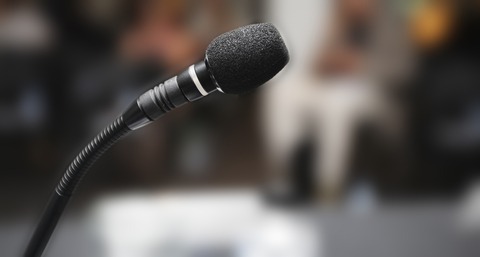Although the deadlines to submit presentation proposals for most healthcare and design conferences that are being held in the next 6-12 months are past, it's not too early to start thinking about it for next year.
Because speaking at healthcare and design conferences is a good way to promote your work or organization and establish yourself as an expert.
And, if you're on a tight budget, it's a good way to help pay the costs of attending, as most conference organizers provide free or discounted registration to speakers.
But how do you craft a conference presentation proposal that will wow the selection committee and get accepted? Here are six tips:
1. Know Your Audience
Make sure your topic resonates with the issues and challenges facing the participants who attend the conference. Many conference organizers list topic areas on their Call for Presentations. Project case studies, new research, trends, or "how to" presentations are good.
2. Have a Co-Presenter
Even if you're a well-known expert, teaming up with other experts can make your session even more appealing. Some conference organizers actually prefer it. And, if you're a vendor or service provider, partnering with a client who matches the profile of the attendees is probably the best way to get on the program.
3. Write an Engaging Session Description
Don't just write about what you're going to talk about, explain how you're going to talk about it. In other words, tell a story. What is the problem you're going to talk about? What solutions to the problem are you going to present? How will you engage attendees?
Also, don't make it about you. Good session descriptions focus on what's in it for attendees, not about the speaker(s).
4. Come Up With a Catchy Title
The session description is what sells those making the decisions to choose yours, but it's the title that catches their eye -- and the eye of attendees when it's printed in the program or on the website. Using a two-part title is a way to blend the sizzle with the salt.
Some good ones from last year's Healthcare Design conference:
- "To 3P or Not 3P, That is The Question"
- "Mock It and They Will Come: The Architectural and Clinical Aspects of Exam Room Concepts"
- "Disinfection is One Thing, Eliminating Environment as a Source of HAIs and Low HCAHPS is Everything!"
5. Follow the Rules
This may seem like a no-brainer, but if the conference organizer asks you to provide three learning objectives, provide three learning objectives. Stay within the word limits (although most online submittal forms force you to do this).
Submit by the deadline. Also, don't craft your session proposal in the online submittal form. Instead, polish it up in a Word.doc first.
6. Have Someone Else Look at Your Proposal
You wouldn't submit a proposal to clients or colleagues without someone else looking at it, would you? This is no different.
Show your Word.doc to a marketing person or a colleague who is good at wordsmithing and proofing.
If At First You Don't Succeed
Try again next year. Or try a different conference. There are many reasons why conference proposals don't get accepted. So don't get discouraged if yours is rejected.
When to Submit
If you're on the email list for these conferences, you'll probably get their Call for Presentations. Exact deadline dates for 2019 conference presentation proposals haven't been announced yet, but they are usually the same time every year:
- June: Environments for Aging Expo & Conference (still time - proposals due June 29!)
- July: Beryl Institute Patient Experience Conference
- August: AIA Conference on Architecture
- October: NeoCon
- January: Healthcare Design Expo & Conference
- March: IFMA's World Workplace
- May: ASHE Planning & Design Conference, Planetree Annual Conference
P.S. Please do me a favor -- if you liked this post and like this blog, please share it with others by sending them the link and/or post it on your Twitter, LinkedIn, or Facebook, etc. Also, don't forget to subscribe, so you'll get emails when new content is posted. Thanks!







